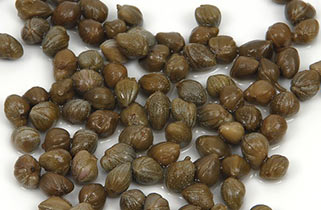What are Capers?
Caper is derived from the Latin word capra , which means “goat,” a name that reflects its strong smell. Thought to originate from the Near East or Central Asia, it has been used by Arabs for medicinal purposes. Caper is the green, dried bud of an unopened flower. It is graded based on its size—the smaller, the higher the grade. Usually, it is cured with brine, vinegar, or oil. Capers have a sharp fermented bitter taste, and its characteristic taste is developed when placed in vinegar or brine. Pickled capers have an acrid, tart, and pungent taste with a lemony tang.
Origin and Varieties
Capers grow wild in the Mediterranean and is cultivated in Spain, France, Italy, Greece, Algeria, Cyprus, and Iran. There are some wild varieties that are used in northern regions of south Asia.
Chemical Components
Capers contain mainly water (85%), bitter glycosides (such as rutin and glucocapparin), pentosans, rutic acid, pectin, and saponin. Similar to mustard or wasabi , upon enzymatic action, methyl glucosinate releases methyl isothiocyanate which gives capers its pungency. Rutin is the whitish spots (crystallizes during pickling process) on pickled capers. It has high sodium content.
Cooking with Capers
Capers have been pickled by Southern Europeans for over 2000 years. Today, they are consumed abundantly in the Mediterranean regions of Sicily, Apulia (in Italy), France, Spain, and Greece. Sicilians add capers to tomato sauces and wines with onions, garlic
, green olives, and fresh leafy spices (such as basil
, oregano
, and chervil
), game, pizzas, chicken, caponata (a salad that includes eggplant
and tomatoes), tartar sauce, and fish. Apulians in Italy use caper with meatballs, string beans, and other boiled vegetables. The Spanish crush it, combine it with almonds, garlic
, and parsley
which is then served over fried fish. Tapenade, a salty pungent spread with capers, black olives, garlic, anchovies, black pepper
, mustard
, and other ingredients
, is a popular appetizer in Provence, France. Capers pair well with fish, olives, chicken, basil
, mustard, black pepper
, garlic, oregano, and tarragon
. Because heat easily destroys its aroma, caper is added to cold dishes of fish, meat, and vegetables. In the United States and northern Europe, it is served as a garnish for cold fish, roasts, and salads, as a spread, and added to pickles and relishes. Capers are also used to add tartness to the curried dishes of northern India.
Spice Blends:tapenade, pickling blend, caponata blend, and pizza sauce blend.
Health Benefits of Capers
Capers have been used to aid digestion, prevent diarrhea, and increase appetite. In India, they were used as a traditional treatment against scurvy.
Other Names
Caper is also called kubar (Arabic), kabra (Bengali), chee san gam, shi shan (Cantonese, Mandarin), (Dutch), capres (French), kaper (German, Norwegian), kappari (Greek), tzalaf kotsani (Hebrew), kiari, kabra (Hindi), cappero (Italian), melada (Malaysian), keipa (Japanese), alcaparra (Portuguese), kabarra (Punjabi), kapersy (Russian), alcaparra (Spanish), mruko (Swahili), kapris (Swedish), alcapparas (Tagalog), kokilakshmu (Telegu), gebre kapari (Turkish), kabar (Urdu), and cap (Vietnamese).
Scientific Name
Capparis spinosa
Family: Caparidaceae (closely related to the cabbage family)
Image by Francisco de la Carrera from Pixabay



